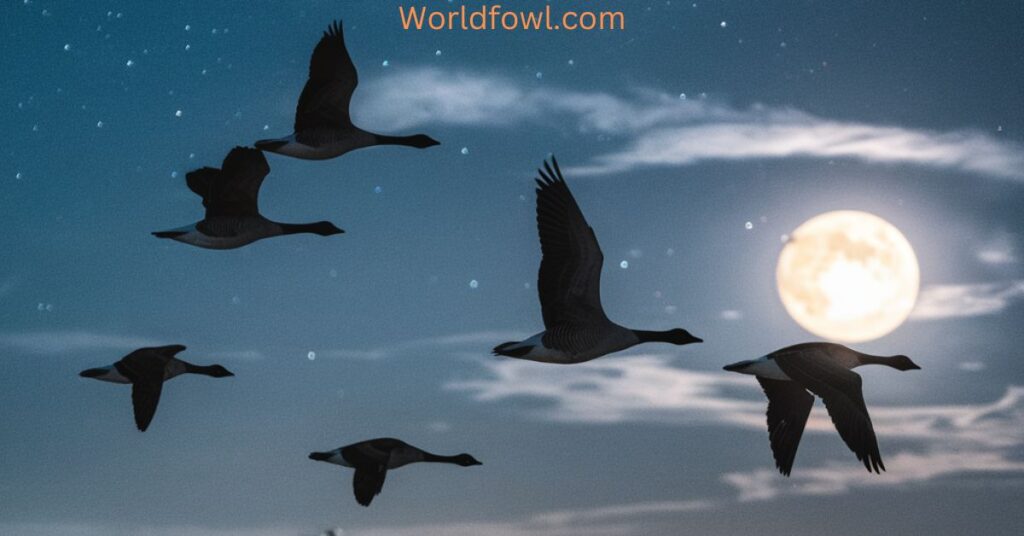Have you ever been startled by the sound of honking overhead on a quiet night? You’re not alone. Many people wonder, “Do geese fly at night?” This comprehensive guide will explore the fascinating world of nocturnal goose behavior, shedding light on their nighttime flights and the remarkable adaptations that make it possible.
Geese: Day Birds or Night Owls?
When we think of geese, we often picture them waddling around parks or flying in their iconic V-formation during the day. But are geese nocturnal, or do they prefer the daylight hours?
Understanding Goose Daily Rhythms
Geese, like most birds, are primarily diurnal creatures. This means they’re generally active during the day and rest at night. However, nature rarely deals in absolutes, and geese have shown remarkable flexibility in their activity patterns.
“Geese are adaptable creatures. While they prefer daytime activities, they’re not strictly bound to them,” says Dr. Jane Hartley, an ornithologist at the University of Michigan.
Comparing Geese to Truly Nocturnal Birds
To appreciate the nighttime behavior of geese, it’s helpful to contrast them with truly nocturnal birds:
| Characteristic | Nocturnal Birds (e.g., Owls) | Geese |
| Primary Activity Time | Night | Day |
| Eye Structure | Large, highly light-sensitive | Adapted for day, with some night vision capability |
| Hunting/Feeding | Primarily at night | Primarily during day, can feed at night if necessary |
| Vocalization | Often silent or soft calls | Loud honking, day or night |
| Migration Patterns | Often migrate at night | Can migrate day or night |
As we can see, while geese aren’t typically classified as nocturnal, they do exhibit some flexibility in their activity patterns, especially during migration seasons.
The Nighttime Flight Phenomenon
Evidence of Geese Flying After Dark
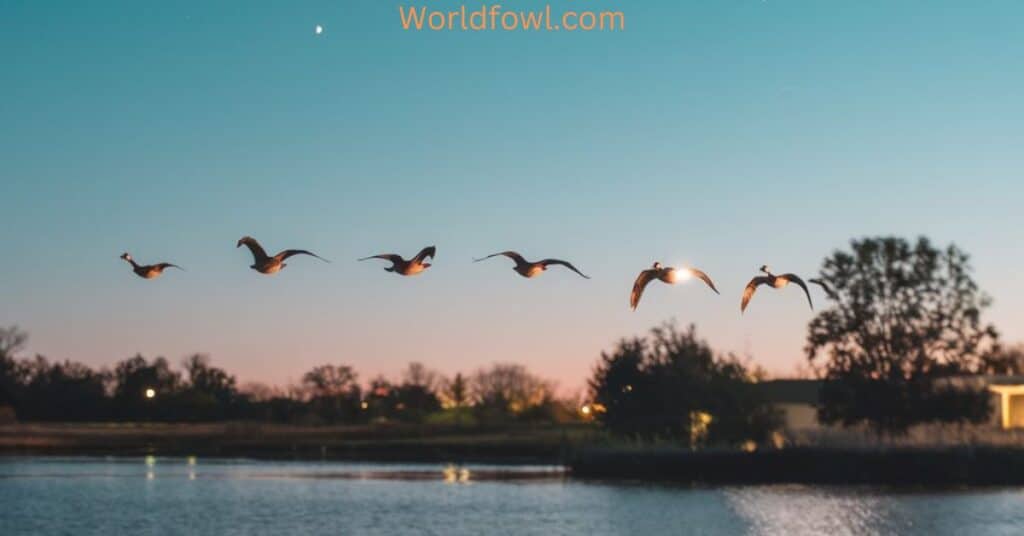
Numerous observations and studies have confirmed that geese do indeed fly at night. This behavior is particularly noticeable during migration seasons when geese cover vast distances in their journey to breeding or wintering grounds.
Factors Influencing Nocturnal Goose Activity
Several factors can prompt geese to take to the skies after dark:
- Migration urgency: During peak migration periods, geese may fly continuously for long stretches, including through the night.
- Weather conditions: Favorable winds or the need to avoid storms can influence flight times.
- Human disturbance: In areas with high human activity during the day, geese might opt for quieter nighttime flights.
- Predator avoidance: Flying at night can help geese avoid certain daytime predators.
you may also like : Where Do Hummingbirds Go At Night? Hummingbird Night Life Exposed
Reasons Behind Nighttime Flights
Migratory Patterns and Long-Distance Travel
One of the primary reasons geese fly at night is to cover more ground during their migratory journeys. Geese migration is an energy-intensive process, and flying during cooler nighttime hours can offer several advantages.
Benefits of Nighttime Migration:
- Reduced heat stress
- Calmer air currents
- Less turbulence
- Energy conservation
Avoiding Daytime Predators and Human Disturbances
Nighttime flights can provide geese with a measure of safety from certain threats:
- Predator evasion: Many avian predators, such as eagles and hawks, are less active at night.
- Human activity: Flying at night allows geese to avoid areas of high human activity, such as airports or busy waterways.
Thermoregulation and Energy Efficiency
Flying at night can help geese maintain optimal body temperature and conserve energy:
- Cooler air temperatures reduce the risk of overheating during strenuous flight.
- Less solar radiation means geese don’t have to expend energy on cooling mechanisms.
Responding to Weather Patterns and Wind Conditions
Geese are adept at reading weather patterns and can adjust their flight times to take advantage of favorable conditions:
- Tailwinds: Nighttime often brings steadier winds that can assist long-distance flight.
- Storm avoidance: Geese may fly at night to circumvent approaching storm systems.
The Goose’s Night Vision Capabilities
For geese to navigate successfully at night, they must have some ability to see in low-light conditions. But how good is their night vision?
Anatomy of a Goose’s Eye
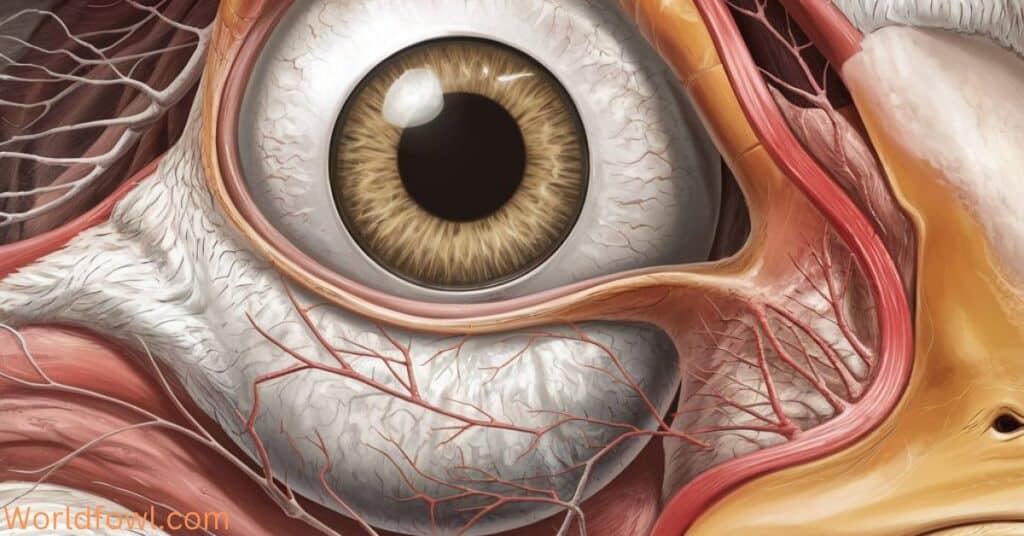
Geese, like many birds, have eyes that are well-adapted for daytime vision but also capable of functioning in low light:
- Large eyes: Relative to their body size, geese have large eyes that can gather more light.
- Retinal structure: Their retinas contain both rods (for low-light vision) and cones (for color and detail).
you also like : Can Seagulls Breathe Underwater? How Do Seagulls Avoid Drowning?
Light Sensitivity and Adaptation to Low-Light Conditions
While not as specialized for night vision as owls, geese do have several adaptations that aid in nighttime sight:
- Higher rod-to-cone ratio: This allows for better vision in dim light.
- Rapid dark adaptation: Geese can adjust to darkness more quickly than humans.
- UV sensitivity: Some evidence suggests geese can see in the ultraviolet spectrum, which may aid navigation.
Comparison with Human Night Vision
Geese likely have better night vision than humans, but it’s not as advanced as true nocturnal animals:
| Aspect | Human | Goose | Owl (for comparison) |
| Low Light Sensitivity | Moderate | High | Very High |
| Color Vision at Night | Poor | Moderate | Poor |
| Field of View | ~180° | ~340° | ~110° (but can rotate head 270°) |
| Movement Detection | Moderate | High | Very High |
Navigation in the Dark
One of the most fascinating aspects of geese flying at night is their ability to navigate accurately over long distances in low-light conditions.
The Role of Celestial Cues (Stars, Moon)
Geese, like many migratory birds, use celestial navigation to guide their nighttime flights:
- Star patterns: Geese can orient themselves using the positions of stars, particularly the North Star.
- Moon position: The moon’s location and phase can provide directional cues.
Earth’s Magnetic Field and Internal Compasses
Geese possess an innate ability to detect the Earth’s magnetic field, which aids in their navigation:
- Magnetoreception: Specialized cells in their eyes and beaks allow geese to “see” magnetic fields.
- Internal compass: This magnetic sense acts like an internal compass, helping geese maintain their course.
Landmarks and Memory in Nighttime Orientation
Despite flying at night, geese still rely on visual landmarks for navigation:
- River systems: Major waterways serve as navigational guides, even in low light.
- Mountain ranges: Distinct topographical features can be discerned against the night sky.
- City lights: In modern times, the glow of urban areas can serve as navigational beacons.
“Geese have an incredible memory for landscapes. Even flying at night, they can recognize key features that guide their journey,” notes Dr. Sarah Chen, a behavioral ecologist specializing in avian migration.
Species-Specific Nocturnal Behaviors
Not all geese exhibit the same nighttime flying behaviors. Let’s look at some species-specific differences:
Canada Geese vs. Snow Geese
Canada Geese (Branta canadensis):
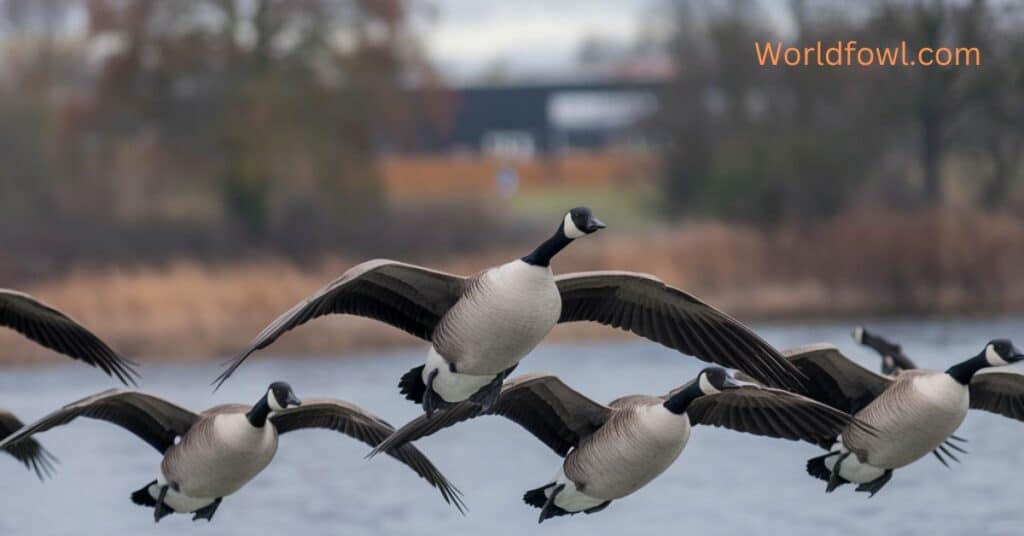
- Often observed flying at night, especially during migration
- Adaptable to urban environments, may fly at night to avoid human activity
Snow Geese (Chen caerulescens):
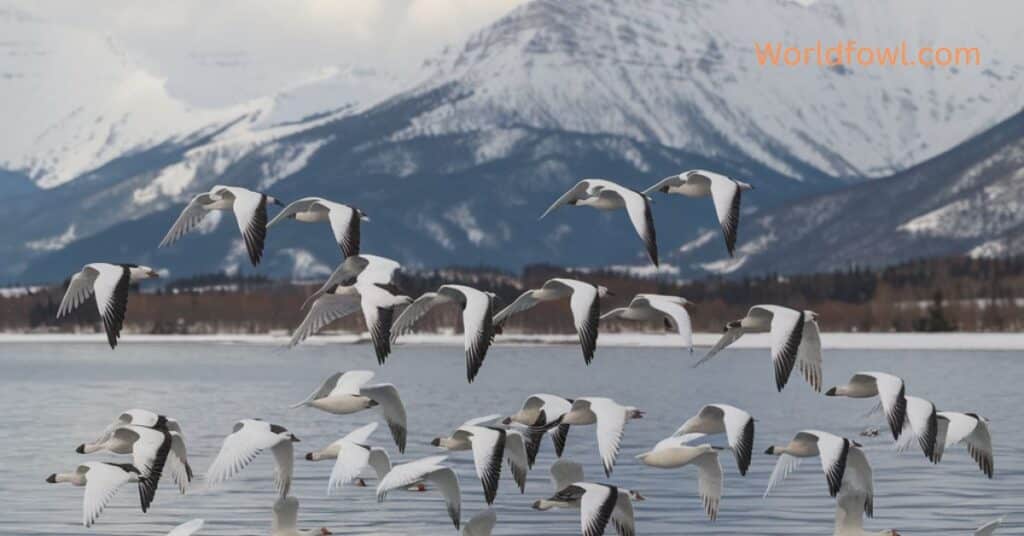
- More likely to migrate during daylight hours
- Will fly at night if conditions are favorable or to make up lost time
Variations Among Other Goose Species
- Brant Geese: Known for long, non-stop flights that often include nighttime travel
- Greater White-fronted Geese: Regularly observed migrating at night
- Barnacle Geese: Studies have shown they adjust their migration timing based on Arctic day length, often resulting in nighttime flights
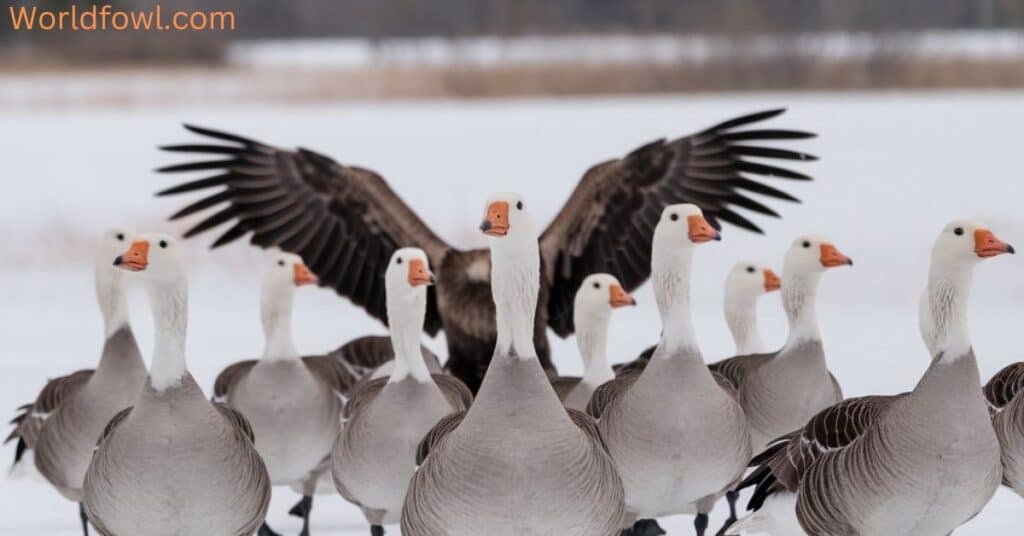
The Challenges of Nighttime Flight
While flying at night offers certain advantages, it also presents unique challenges for geese.
One of the greatest dangers for geese flying at night is the risk of colliding with:
- Tall buildings
- Communication towers
- Wind turbines
- Power lines
Case Study: Bird-Friendly Design
In Toronto, Canada, the Fatal Light Awareness Program (FLAP) has successfully advocated for bird-friendly building designs, reducing nighttime collisions by up to 80% in some structures.
you might like : Do Robins Mate For Life? The Complete Guide To Robin Romance
Disorientation Due to Light Pollution
Artificial lighting can confuse and disorient geese flying at night:
- Attraction to light: Bright lights can draw geese off course.
- Loss of celestial cues: Light pollution can obscure stars, hampering navigation.
Increased Vulnerability to Certain Predators
While nighttime flight helps avoid some predators, it can make geese more vulnerable to others:
- Owls: Great horned owls and other large owl species may prey on geese at night.
- Nocturnal mammals: In areas where geese land to rest, they may be at risk from foxes or coyotes.
Sleep Patterns and Rest During Migration
The ability of geese to fly at night raises questions about their sleep patterns, especially during long migratory journeys.
How Geese Balance Sleep and Long-Distance Flights
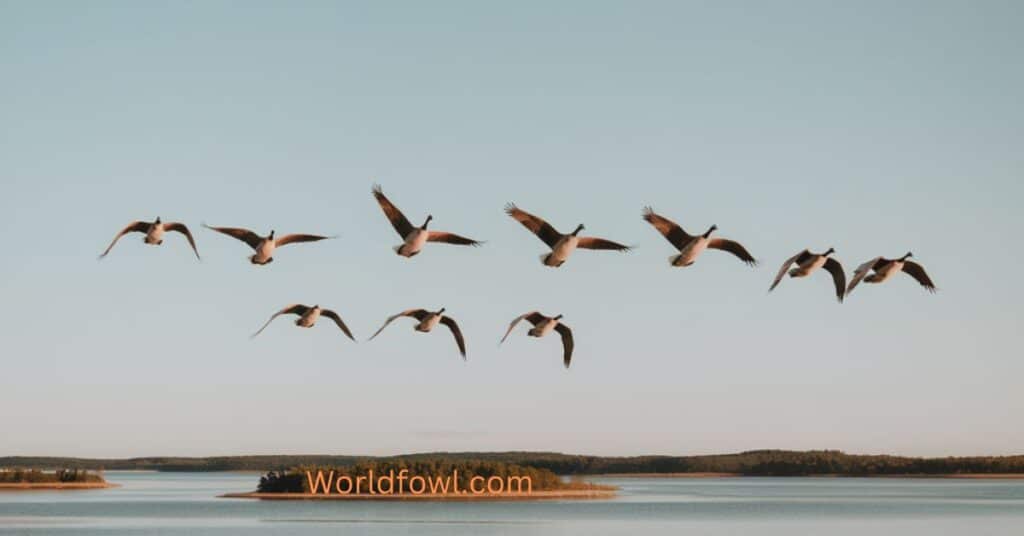
Geese have evolved remarkable adaptations to manage sleep during migration:
- Short sleep bursts: Geese can take very short naps, sometimes lasting only seconds.
- Sleep while flying: Some evidence suggests geese may be able to enter brief sleep states while in flight.
The Phenomenon of Unihemispheric Slow-Wave Sleep
Like many birds, geese are believed to be capable of unihemispheric slow-wave sleep:
- One half of the brain remains alert while the other half sleeps.
- This allows geese to rest while still maintaining awareness of their surroundings.
- Particularly useful during long flights or when resting in potentially dangerous areas.
Human Impact on Nocturnal Goose Behavior
As human activity continues to expand, it inevitably affects the behavior of wildlife, including the nighttime habits of geese.
Effects of Urbanization and Artificial Lighting
Urban development has had mixed effects on geese flying at night:
Positive Impacts:
- City lights can serve as navigation aids
- Urban heat islands may provide thermal benefits
Negative Impacts:
- Increased collision risks
- Disruption of natural day-night cycles
- Potential confusion during navigation
Conservation Efforts to Protect Nighttime Flight Paths
Recognizing the importance of safe passage for migrating birds, many initiatives have been launched to protect nighttime flyers:
- Lights Out Programs: Encouraging buildings to turn off or dim lights during peak migration seasons.
- Bird-Safe Building Guidelines: Promoting designs that reduce collision risks.
- Dark Sky Preserves: Establishing areas with minimal light pollution to aid nocturnal navigation.
you can read : Crane Vs. Heron – The Complete Comparison
Observing Geese at Night: Tips for Enthusiasts
For those interested in witnessing the nighttime flights of geese, here are some tips:
Best Times and Locations for Nighttime Goose Watching
- Peak Migration Seasons: Spring (March-May) and Fall (September-November)
- Full Moon Nights: Increased visibility for both geese and observers
- Near Water Bodies: Lakes, rivers, and wetlands are popular stopover points
Equipment and Techniques for Ethical Observation
- Night Vision Binoculars: For better viewing without disturbing the birds
- Sound Recording Equipment: To capture nighttime honking
- Red-Light Flashlights: Less disruptive to birds’ night vision
- eBird App: To record and share your observations with the scientific community
Remember: Always prioritize the well-being of the birds. Maintain a respectful distance and avoid using flash photography or bright lights.
Conclusion
The phenomenon of geese flying at night is a testament to the remarkable adaptability and navigational prowess of these birds. From their enhanced night vision to their ability to use celestial and magnetic cues, geese have evolved a suite of tools that allow them to take advantage of nighttime conditions when necessary.
As we’ve explored, nighttime flights serve various purposes:
- Efficient long-distance travel during migration
- Avoiding daytime predators and human disturbances
- Taking advantage of favorable weather conditions
However, these nocturnal journeys also come with challenges, particularly in our increasingly urbanized world. Understanding these nighttime behaviors is crucial not only for our appreciation of these magnificent birds but also for informing conservation efforts to ensure their continued safe passage.
The next time you hear the distant honking of geese on a quiet night, you’ll know that you’re witnessing a remarkable feat of nature – one that continues to inspire awe and scientific inquiry.
FAQs
Do all geese fly at night, or just during migration?
While geese are capable of flying at night, it’s most common during migration. Outside of migration periods, nighttime flights are less frequent but can occur due to disturbances or local movements.
Can geese see colors in the dark?
Geese have color vision, but like most animals, their color perception is limited in low light conditions. They rely more on contrast and movement detection at night.
How fast do geese fly at night compared to daytime?
Geese typically fly at similar speeds day or night, averaging 40-50 mph. However, nighttime tailwinds can sometimes allow for faster travel.
Do geese make noise while flying at night?
Yes, geese often vocalize during nighttime flights. Their honking serves as a way to maintain flock cohesion and communicate in the darkness.
How do weather conditions affect nighttime goose flights?
Weather significantly impacts nighttime flights. Geese prefer clear nights with favorable winds. They may delay flights during heavy rain, fog, or strong headwinds to conserve energy and ensure safe travel.

Henry James is a seasoned blogger and a passionate storyteller on “World Fowl.” With years of experience crafting engaging content, he brings a unique blend of expertise and creativity to his writing. Henry specializes in exploring diverse topics with depth and clarity, captivating readers worldwide.

